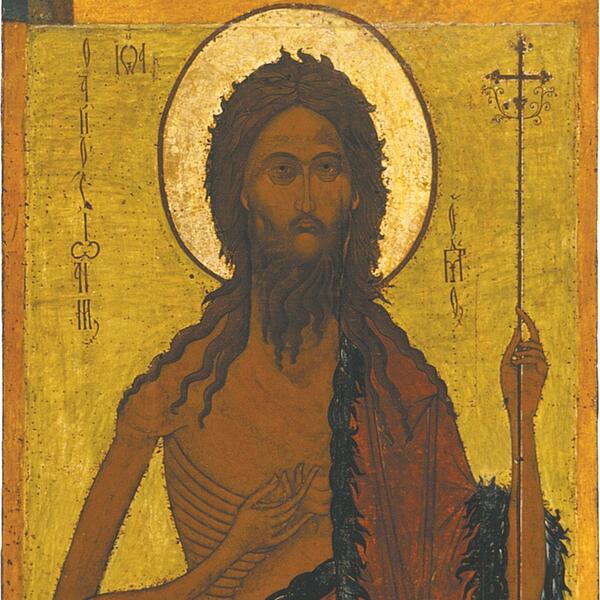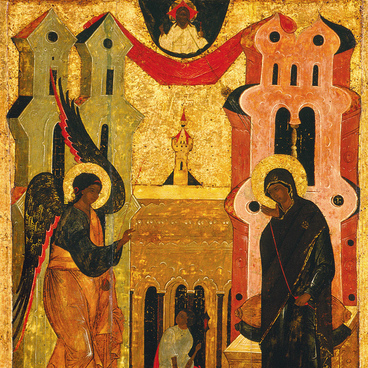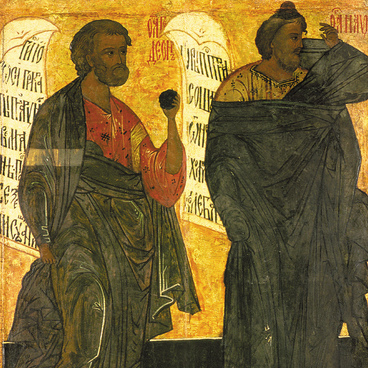John the Forerunner was the last of the prophets and forerunners of Jesus. He foretold the coming of Jesus and prepared people for this event by performing ritual practices that involved washing and later transformed into the sacrament of baptism. He also baptized Jesus in the Jordan River. This is how he received his most popular name John the Baptist.
After “the word of God came unto John the son of Zacharias”, John lived as an ascetic and led a solitary life. He wore a melote, a robe made of coarse camel skin, and ate wild honey and locusts. According to an early Byzantine legend, John was five months old when an angel ordered his mother, the righteous Elizabeth, to wean him from breastfeeding so that he could get used to that kind of food.
John started preaching in 28 or 29 AD, “in the fifteenth year of the reign of Tiberius Caesar” (Luke 3:1) and he “came into all the country about Jordan, preaching the baptism of repentance for the remission of sins” (Luke 3:3). The Gospels quote his teachings addressed to Pharisees, warriors, tax collectors, and other people. In these teachings, John cautioned them against making false accusations, insulting others, and wishing to get more than was envisaged by God, “Exact no more than that which is appointed you” (Luke 3:13).
His followers, “John’s disciples” also led strictly ascetic lives. An account of John the Baptist is found in all manuscripts of the “Antiquities of the Jews” by Flavius Josephus (the 1st century AD).
In Russia, the images of John the Baptist became especially widespread during the reign of Ivan the Terrible. They are characterized by the dramatic nature, asceticism, and austerity of the saint, with his exhausted appearance emphasizing the strength of his faith. The images are characterized by a monumental character. Russian icons were based on Byzantine images of the 11th century.
The camel-skin robe refers to the fact that this animal was traditionally viewed as unclean. This symbolizes the preaching of John the Baptist who was equally eager to help both Jewish people and “unclean” heathens get closer to God. Although it is not shown in this icon, John is also often depicted wearing a leather belt made of the skin of a dead animal which designates the suppression of the desires of the flesh. With the right hand, John the Baptist makes the signs of I and X, forming the abbreviation of the Savior’s name.
The icon was placed in the Church of the Exaltation of the Holy Cross that belonged to the Tolga Convent near Yaroslavl. As a local legend has it, the icon was donated by Tsar Ivan the Terrible. Perhaps, he did it out of gratitude for the miraculous healing of his “leg disease” after praying to the icon of Our Lady of Tolga.
After “the word of God came unto John the son of Zacharias”, John lived as an ascetic and led a solitary life. He wore a melote, a robe made of coarse camel skin, and ate wild honey and locusts. According to an early Byzantine legend, John was five months old when an angel ordered his mother, the righteous Elizabeth, to wean him from breastfeeding so that he could get used to that kind of food.
John started preaching in 28 or 29 AD, “in the fifteenth year of the reign of Tiberius Caesar” (Luke 3:1) and he “came into all the country about Jordan, preaching the baptism of repentance for the remission of sins” (Luke 3:3). The Gospels quote his teachings addressed to Pharisees, warriors, tax collectors, and other people. In these teachings, John cautioned them against making false accusations, insulting others, and wishing to get more than was envisaged by God, “Exact no more than that which is appointed you” (Luke 3:13).
His followers, “John’s disciples” also led strictly ascetic lives. An account of John the Baptist is found in all manuscripts of the “Antiquities of the Jews” by Flavius Josephus (the 1st century AD).
In Russia, the images of John the Baptist became especially widespread during the reign of Ivan the Terrible. They are characterized by the dramatic nature, asceticism, and austerity of the saint, with his exhausted appearance emphasizing the strength of his faith. The images are characterized by a monumental character. Russian icons were based on Byzantine images of the 11th century.
The camel-skin robe refers to the fact that this animal was traditionally viewed as unclean. This symbolizes the preaching of John the Baptist who was equally eager to help both Jewish people and “unclean” heathens get closer to God. Although it is not shown in this icon, John is also often depicted wearing a leather belt made of the skin of a dead animal which designates the suppression of the desires of the flesh. With the right hand, John the Baptist makes the signs of I and X, forming the abbreviation of the Savior’s name.
The icon was placed in the Church of the Exaltation of the Holy Cross that belonged to the Tolga Convent near Yaroslavl. As a local legend has it, the icon was donated by Tsar Ivan the Terrible. Perhaps, he did it out of gratitude for the miraculous healing of his “leg disease” after praying to the icon of Our Lady of Tolga.




